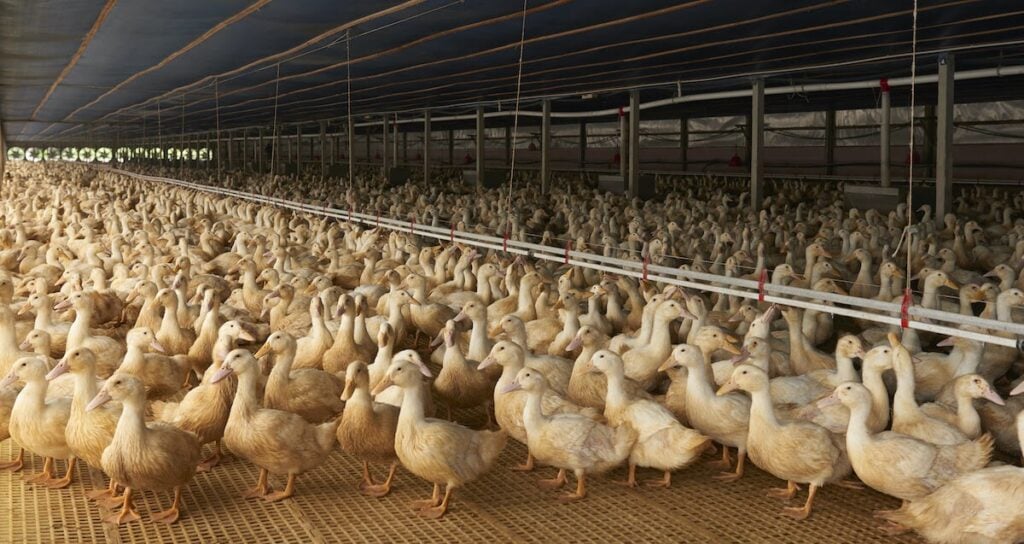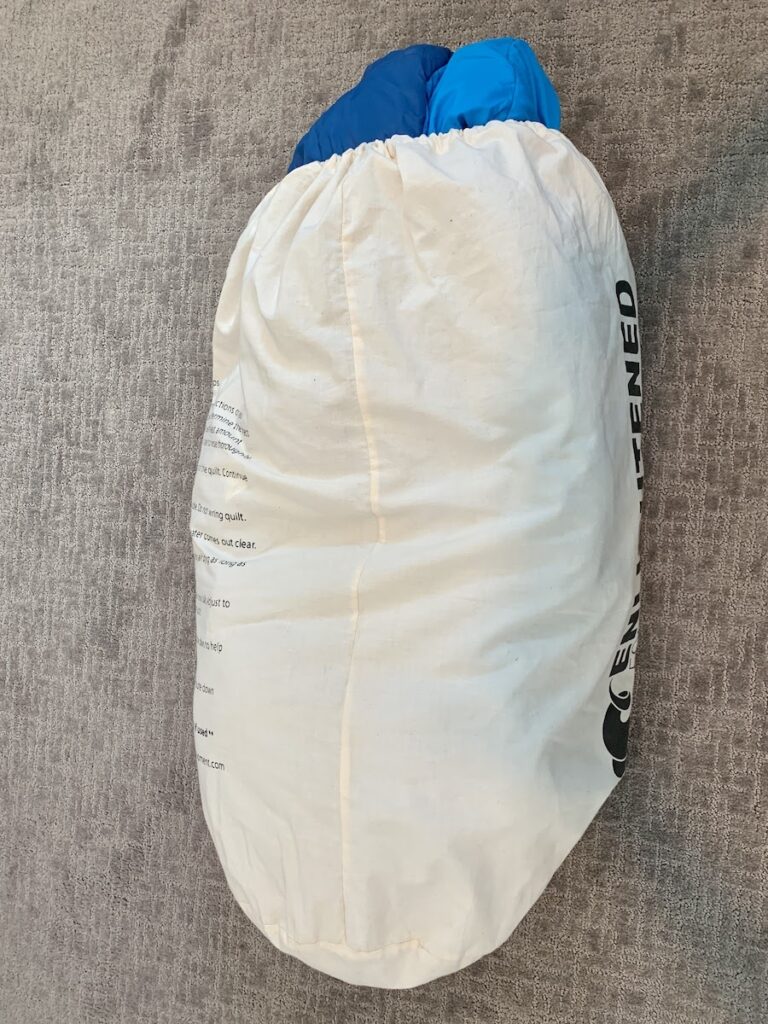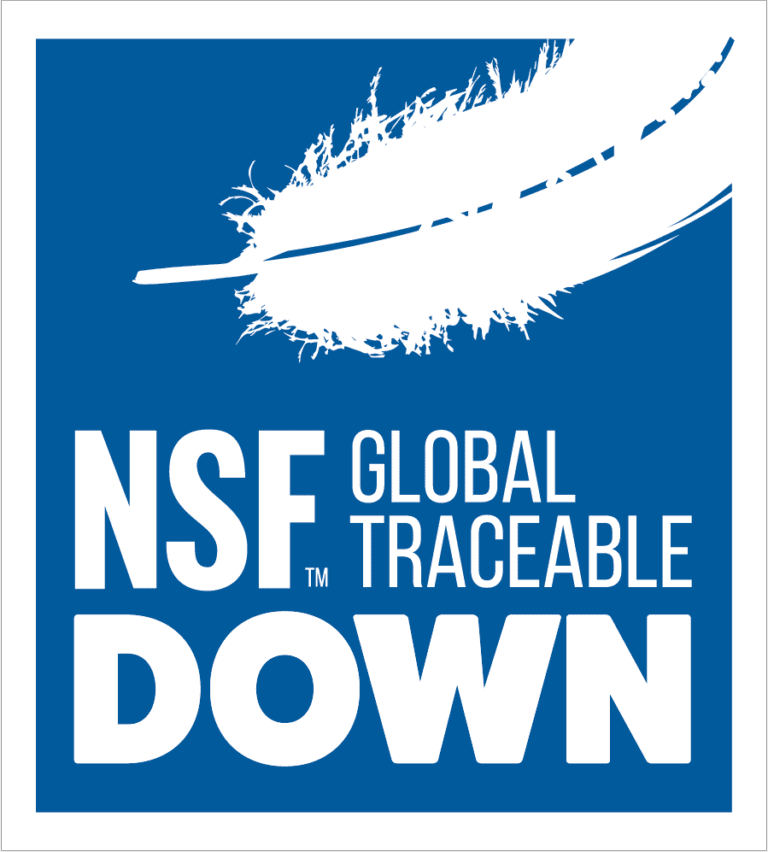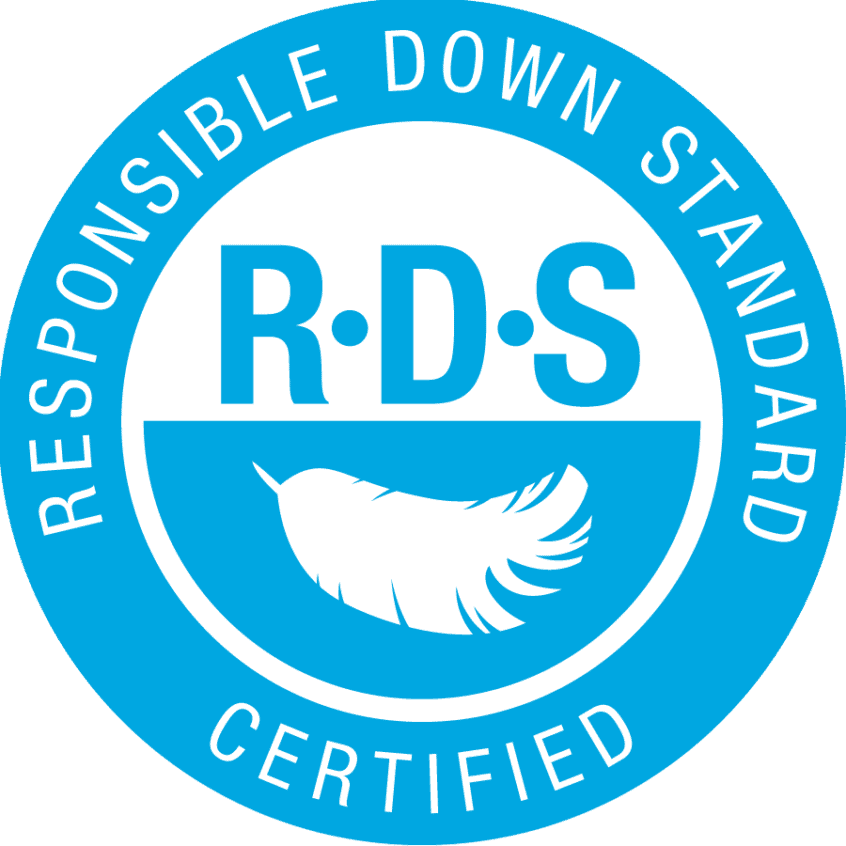Responsible Down Standard: Is Down Outdoor Gear Ethical or Eco-Friendly?
Is there such a thing as sustainable and ethical down? We’ve done some research and you can read everything we’ve discovered about down outdoor gear in this blog post.

Since adopting a plant-based diet and giving up all animal foods, I’ve realized just how much of my outdoor gear contains animal products. Ski gloves made from goat leather, socks and base layers made of wool, and my sleeping bag and warm jacket made of down. It seems like almost every time I’m on an outdoor adventure, I’m wearing or using something made from animals. It wasn’t until I ditched meat in my diet that I started to think about my ethics in regards to utilizing animal products in my gear, particularly whether down is ethical and humane. I’d heard about the Responsible Down Standard when shopping for down sleeping bags and jackets, but I wasn’t quite sure what that meant.
I want to buy gear that is ethical and eco-friendly and to support outdoor companies that are making efforts to reduce their environmental footprint. At the same time, I want to minimize the harm caused to animals in the making of my gear. So I’ve been doing some research on the ethical and environmental implications of common materials in outdoor gear, and in this blog post, I share what I’ve learned about down.
With down being one of the lightest, warmest, and most compressible insulating materials for sleeping bags, swapping down for synthetic often means carrying a heavier and bulkier sleeping bag and often sacrificing temperature performance. As someone who makes recommendations for the most functional outdoor gear (where weight and performance are big factors), I’ve felt a bit conflicted about this. It’s led me to ask whether down is sustainable, ethical, and eco-friendly and to dig into what the Responsible Down Standard means. Touted as a natural, eco-friendly material, I also wondered how down compares to synthetic alternatives in terms of environmental impact.
Advance warning, this blog post is detailed, and may be a little difficult to read, but you’re likely to learn some new, surprising things about down. My goal with this blog post isn’t to steer you in a certain direction or to make you feel guilty about the gear you own or even buy in the future. I personally own a number of down sleeping bags and jackets that I love. Instead, my hope is that as we strive to be more conscious consumers and that this information will help us make more thoughtful, ethical, and responsible choices when it comes to future outdoor gear purchases.
In this blog post, I share what I’ve found in regards to how down is produced, all about the Responsible Down Standard, and tips for making ethical and eco-friendly choices when shopping for jackets, sleeping bags, and other products commonly made from down.
What is down?
Down is the light, fluffy undercoat of waterfowl (typically ducks and geese) that keeps them nice and toasty. These quill-less fibers are one of nature’s most effective insulating materials. Down is extremely light and compressible with an excellent warmth-to-weight ratio, making it the material of choice in backpacking sleeping bags and insulating jackets. My guess is some piece of your outdoor kit (or even your bed comforter at home) is made of down.

Where does down come from?
Down is produced in 3 different ways, with a majority of down on the market produced in China.
1. Collecting Down from Wild Eider Duck Nests
This is the only way to sustainably produce down where the ducks are not harmed or killed for the meat industry. Eider ducks are wild birds that live in arctic and subarctic coastal marine environments in the North Atlantic (mainly Iceland and Norway).
When the mother eiders are laying their nests, they pluck their own down in order to line their nest and incubate their eggs. Once the eggs hatch, the mother and her ducklings abandon the nest and head out to sea. Then, harvesters or “farmers” come through and collect the down from the nests.
Before you get too excited about this type of down, eiderdown comforters cost anywhere from $5,000 to $16,000. Because of the cost, my guess is most of us don’t have and will never own outdoor gear made from eider ducks.
2. Live plucking
A practice that the industry claims is rare, live-plucking is when geese and ducks are restrained and plucked alive. This process can start when the geese are as young as 6 weeks old and is repeated up to 6 times before they are killed for their meat¹.
Since they are plucked multiple times before death, this practice produces more down than plucking a single time after slaughter. This is painful and considered one of the cruelest ways to produce down.
3. Plucked after Slaughter for Meat
The third and most common source of down comes from plucking the geese and ducks after they have been killed for meat. After the ducks and geese are killed, they are dropped in scalding water for 1-3 minutes which makes the feathers and down easier to pluck.
In 2017, nearly 3.7 billion ducks and geese were killed for the global meat trade². The largest demand for geese and duck meat is in China (6 million tons a year), followed by France and Myanmar. By 2025, the global market is expected to reach nearly 9 million tons of duck and geese³.
How are geese and ducks raised and what are the animal welfare concerns?
A majority of ducks and geese are raised for meat on factory farms and never see the sun or water to swim in. The down is a byproduct of this process. Living indoors without water to swim in deprives them of their natural habitat and instincts and many of the animals show signs of distress in these conditions.
Issues on Industrial Duck and Geese Farms
The duck farm below is typical of the United States, but keep in mind that 80% of duck and geese are produced in China.

According to the Food Empowerment Project, on US industrial duck farms, “overcrowded conditions and a lack of natural stimulation cause the birds to peck and pull at their own feathers and the feathers of nearby ducks. Rather than satisfy even their most basic instinctual needs, the industry chooses to cut or burn part of their upper bill without the use of anesthetics. Despite its rigidity, the bill is sensitive to pain and the trimming process is stressful⁴.” Trimming also causes bleeding, tissue damage, and often has to be repeated⁵.
Furthermore, ducks are meant to spend their lives in water and their legs are not meant to hold up their bodies all day long. Their legs and feet often become infected, rendering them unable to walk.
When ducks are transported to the slaughterhouse, broken wings and limbs are common and they can be deprived of food and water for up to 36 hours before their death. Finally, as they go to slaughter, some of the birds are still alive when dropped in the scalding water, essentially boiling them alive.
Issues with Foie Gras Production
The other major animal welfare issue with ducks and geese is the production of foie gras, which requires force-feeding. Most foie gras is produced by confining birds to small cages where they are unable to move. A large feeding tube is stuck down their throat, pumping high-fat corn mash into their stomachs. This lasts between 12-15 days, causes enormous discomfort and damage to the esophagus, and results in a liver that is 7-10 times larger than normal⁶.
What is the Responsible Down Standard?
The above information made me feel really uncomfortable and question whether down can ever be ethical. I personally don’t want my sleeping bag made from geese and ducks raised in this way.
Fortunately, in response to animal abuse and welfare concerns, the Textile Industry developed the Responsible Down Standard (RDS) and many popular outdoor companies, such as REI and The North Face have committed to sourcing their down products in accordance with the Responsible Down standard.
All down products certified by the Responsible Down Standard must not come from live-plucked or force-fed birds. In addition, producers must commit to the protection of the five freedoms:
- Freedom from hunger and thirst
- Freedom from discomfort
- Freedom from pain, injury, or disease
- Freedom to express normal behavior
- Freedom from fear and distress
Farms and slaughterhouses are audited and inspected on an annual basis, with unannounced visits possible. To see the latest Responsible Down Standard requirements, go here.
There is also the Global Traceable Down Standard, which is Patagonia’s certification process that traces down from the parent farm all the way to the garment factory, ensuring animal welfare at every step in the process. The standards are similar to RDS and any Patagonia down products meet the Global TDS requirements.

But the animals are still killed…
The Responsible Down Standard and Global Traceable Down standards ensure that the animals are treated with respect while they are alive, but in the end, they are still killed for their meat.
One of the freedoms in RDS is “freedom from fear and distress.” One could argue that transport and slaughter incite fear and distress and that process is never humane.
This may lead you to question whether down can ever be ethical, and that’s where your own personal belief systems come into play.
What is the role of industrial bird farms in pandemics?
Now that we have all experienced a global pandemic, a lot of attention has turned to how these viruses originate. As it turns out, factory farms are a major culprit for zoonotic diseases (viruses that jump from animals to humans). When animals are living in dirty, confined conditions and experience elevated levels of stress, it weakens their immune system and creates prime conditions for new viruses to spread.
For example, H5N1 (the bird flu) started on a goose farm in China. While H5N1 has only infected 800 people, it is now endemic in 6 countries and has a 50% death rate. So far, there has been no human to human spread of H5N1, but the US Government is now stockpiling a H5N1 vaccine in case the virus mutates and community spread becomes possible⁷.
Similarly swine flu (H1N1) started in farmed pigs and jumped to humans. While this blog post isn’t about pandemics, it’s important to note that if we continue to raise animals on an industrial scale in the way we have been for food and other products, future pandemics are certain to occur.
What is the environmental impact of down?
While down has been touted as a sustainable, natural material, the duck and geese farms themselves do have environmental impacts.
First, it requires 2.5 kg of feed in order to produce 1 kg of duck meat⁸. Furthermore, producing 1 kg of duck meat requires 233 gallons of water. This means, instead of using land, water, and resources to grow food for human consumption, we are using our resources to produce feed for ducks and geese. This is inefficient and wasteful and is an issue no matter what farmed animal you are talking about.
Duck and geese also poop like crazy, which produces methane (a potent greenhouse gas) as well as nitrogen and phosphorus which pollute waterways. I had a hard time finding numbers specific to the duck and geese industries, although data exists for other types of poultry. If you want to learn more about the general environmental impacts of animal agriculture, check out this blog post.
For these reasons, calling down an eco-friendly product is a stretch. On the flip side, a down sleeping bag, if well cared for, can last a very long time. The down is also biodegradable when the product reaches the end of its life.
What are the environmental impacts of the synthetic alternatives?
Synthetic insulation comes with its own environmental issues. There are a number of different brands and types of synthetic insulation – Thermolite, Climashield Apex, Statrofiber, Primaloft. The common thread of all of these is they are made of polyester which is derived from oil and requires nasty chemicals to produce. Furthermore, polyester can shed microplastics when washed and isn’t biodegradable when the product reaches a landfill.
Virgin polyester continues to contribute to our demand for oil, but the good news is that in the outdoor industry, there has been a huge push towards recycled polyester. Recycled polyester is produced by melting down existing plastic (including plastic bottles) and spinning it into new fibers. This means the insulation in your synthetic sleeping bag might be made from recycled plastic water bottles. Companies like Primaloft are also working to reduce emissions during the production process and recently created a new synthetic insulation product called Primaloft Bio that is completely biodegradable.
As a consumer, it’s not always clear what you are buying, so if buying a synthetic sleeping bag or jacket made of recycled material is important to you, you have to pay attention and look for the Responsible Down Standard (or similar) labels to see whether it’s considered eco-friendly.
Personally, I’m hopeful that synthetic technology will not only advance in terms of sustainability but that it will also become more comparable to down in terms of weight and warmth.
Tips for Choosing an Ethical and Environmentally-Friendly Sleeping Bag
If this blog post has left you feeling conflicted, I’m right there with you. Both synthetic and down have their pros and cons, so what is an outdoor enthusiast left to do? Whichever material you decide on, below you’ll find some tips to help you make more sustainable decisions.
Make what you Already Have Work
The most ethical and eco-friendly thing to do is to not buy stuff you don’t need! If you have a sleeping bag that is light and warm enough, it’s not worth buying a new sleeping bag just to save a couple of ounces.
If you are transitioning to a vegan lifestyle and don’t want to use animal products anymore, consider using whatever sleeping bag you currently have until it really needs to be replaced. At that point, you can donate your old down bag to a friend who doesn’t have one or to a person in need.
Take Care of your Stuff so it Lasts as Long as Possible
Taking good care of your sleeping bags and jackets will reduce the number of new things you need to buy. You should loosely store your down sleeping bag either hanging up in the closet or in a large bag (rather than in a tightly compressed stuff sack that will reduce loft over time).

Another option to help your sleeping bag last longer is to purchase a sleeping bag liner to keep your sleeping bag clean and reduce the number of times you’ll have to wash it in its lifetime.
Many companies will also repair gear. If the zipper on your sleeping bag is broken or your bag has a hole in it, see if you can get it repaired before you go out and buy a brand new bag.
Buy Used Gear
Another great way to reduce your footprint is to buy used gear. Many brands now have used gear sections on their websites. Not only is this more eco-friendly, you will also save money! Here are a few places you can buy used gear:
See our blog post on where to buy discounted outdoor gear for additional used gear sites.
Only Buy Down Products that are Certified
If you are shopping for a new down sleeping bag and care about animal welfare, make sure that the one you buy is certified by the Responsible Down Standard (RDS) or the Global Traceable Down Standard. This is your best bet to ensure that the animals were treated humanely on the farm.
Any products with these certifications will be clearly labeled, so keep an eye out for these down labels.


If you don’t see these labels, dig around on the brand’s website. My favorite sleeping bag made by Western Mountaineering isn’t RDS Certified, but they have a clear statement on their website about their ethics and how their down is produced – from egg laying geese.
For synthetics – look for recycled insulation
If you are a firm believer in animal rights and abide by a vegan lifestyle, then your choice is clear – to avoid animal products at all costs. In this case, when searching for the most environmentally friendly synthetic sleeping bag or jacket, you’ll want to read the product description and make sure that the insulation is made from recycled materials.
What are your thoughts on down vs synthetic based on the facts shared in this blog post? How do you feel about the Responsible Down Standard? Please leave your comments down below!
Footnotes:
¹Down With Live Plucked Down
²Animal Charity Evaluators: Trends in Meat Production
³Global Duck & Goose Meat Market to Keep Growing, Driven by Strong Demand in Asia
⁴Food is Power: Ducks
⁵Welfare Implications of Beak Trimming
⁶The Animal Health and Welfare Consequences of Foie Gras Production
⁷Highly Pathogenic Asian Avian Influenza A(H5N1) Virus
⁸Pre-Hatch Growth and Development of Selected Internal Organs of Domestic Duck


An excellent review and the most responsible advice for buying outdoorsy goods, Reuse, Recycle and Repair. My retirement job is on the floor for a national outdoor retailer, I learned a great deal. Thanks-
Great article. It really is difficult to be 100% ecologically and sustainably responsible. But I am thankful for the people like yourself who take the time to research, report, and make the best choice possible.
Thanks for the kind words, Candice! It is hard to be 100% eco-friendly and sustainable, but we try our best 🙂
Thank you so much for your article about ethical down and environmentally responsible gear in general. Such an important topic and nuanced. Your research and writing is much appreciated and I would love to have ongoing information on this topic!
Thanks for that feedback, Teresa!
Amen to the buy less, take care of your stuff more advice. I find that the consumer economy has encouraged buying cheap, low quality, and multiple items for so long that many people think replacement is simply necessary, even if they own good quality items that they could continue using if repaired or properly maintained. Think twice, buy once — make sure you like the clothes you pick out, my mom used to say, because that’s what you’ll be wearing until next year. And hand-me-downs were a normal occurrence. Sustainability isn’t really all that hard.